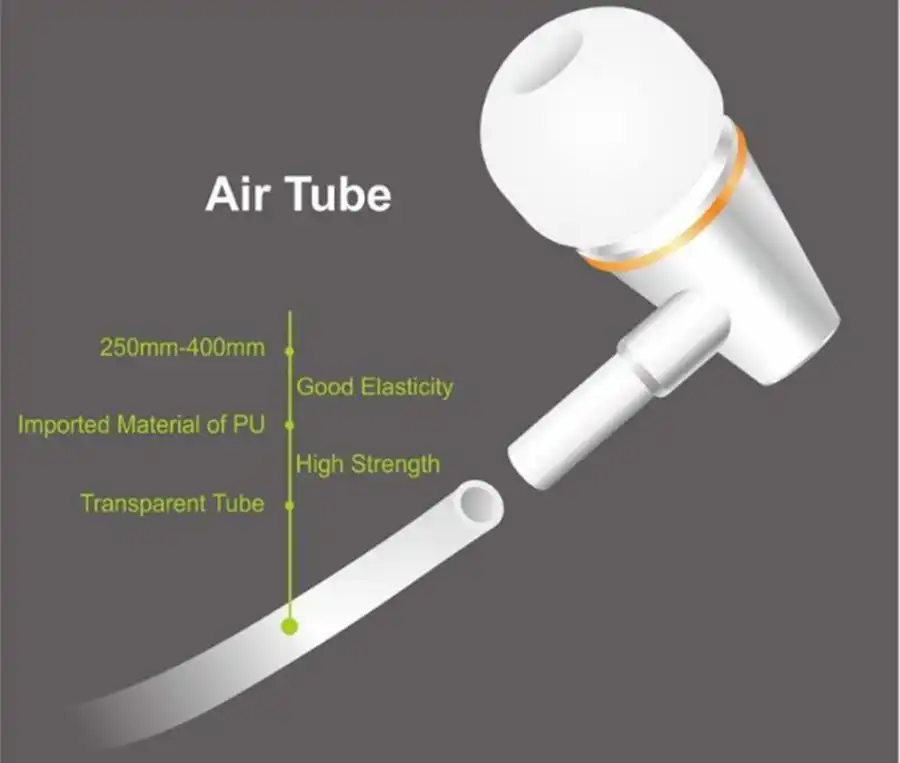Table of Contents
The audio business is always coming up with new ideas, and one such example is the air tube headphones, which are a new kind of headphones that claim to offer unique health benefits.
For those unaware, these headphones feature hollow tubes that allow sound waves from speakers situated at a distance from the ear canal to enter when filled with air. This design aims to reduce the electromagnetic frequencies (EMFs) that some people believe to be harmful to human health. However, to what extent are these claims accurate, and are there any notable advantages to using air tube headphones?
What Are Air Tube Headphones?
Air tube headphones have speakers that are positioned further out from the wearer’s ears than more traditional models. These headphones don’t put the drivers—the tiny speakers—right in the ear canal; instead, they use hollow tubes to convey sound. By lengthening the ear canals, they increase the amount of space between the user’s skull and the electrical components.
Claimed Advantages of Air Tubes
The primary selling point of air tube headphones is their purported ability to lower electromagnetic field exposure. Concerns over the potential health effects of electromagnetic fields (EMFs), a kind of radiation emitted by electronic devices, are growing among some individuals.
Air tube headphones displace the speakers from the wearer’s head, supposedly reducing electromagnetic fields (EMFs) that reach the brain.
This feature would be especially interesting to those who believe they have electromagnetic field hypersensitivity, a condition in which exposure to electromagnetic fields causes poor health effects.
The medical establishment does not yet admit that electromagnetic fields (EMFs) generate electromagnetic hypersensitivity (EMS).
Double-blind studies have shown that people who claim to be hypersensitive to electromagnetic fields (EMFs) are consistently unable to identify when exposed to these fields. Science has not yet determined the fundamental cause, even though these people’s symptoms are genuine.
Do Air Tube Headphones Work?

The idea that using air tube headphones reduces exposure to electromagnetic fields is true. Since the strength of electromagnetic fields (EMFs) decreases substantially with distance, these headphones reduce exposure to EMFs. However, it is crucial to put this decline into perspective. Bluetooth devices and wired headphones emit very low electromagnetic fields (EMF) when compared to standard sources such as cell towers, Wi-Fi routers, and even the Sun.
Audio Quality and Practicality
The design of air tube headphones reduces electromagnetic field strength, but it compromises the quality of the music. The design inherently affects the loudness, clarity, and balance of mid-to-low frequencies. Due to the lower sound quality caused by the air-filled tubes, these headphones frequently don’t perform as well as more traditional models.
Air tube headphones are also often heavier and more brittle. Compared to ordinary headphone cables, the tubes could be bulkier and more readily broken, making them less pleasant to use. With these drawbacks, many users could decide that the little reduction in electromagnetic field exposure is not worth the trade-off between reduced battery life and worse audio quality.
Who Should Consider Air Tube Headphones?
Air tube headphones shield you from electromagnetic fields (EMFs) produced by wireless headphones or earbuds, even if they reduce the sound quality. These headphones can be a suitable option for those who place a higher priority on their health than the sound quality of their music. Remember that normal headphones already emit very little electromagnetic fields (EMFs), so the reduction you get from using air tube headphones may not seem like much when you take your everyday exposure to EMFs into account.
For most people, the most practical alternative may be traditional wired headphones. They create almost no electromagnetic fields, are more durable, and offer better sound quality. There are other strategies you may use as well, such as using EMF shielding materials on cables, to reduce EMF, but since these devices are so power-poor, the actual effect will be minimal.
Additional Considerations
It should be noted that individual differences exist in EMF sensitivity. Some individuals may be quite concerned even with very little exposure, while others may not be harmed at all. Furthermore, the market for air tube headphones offers fewer options than the mainstream headphones sector does.
Conclusion
As promised, air tube headphones reduce electromagnetic field exposure by positioning the electrical parts of the headphones away from the wearer’s head. Most customers find them less appealing because their compromised functionality and audio quality cast doubt on the effectiveness of this reduction, given the already low EMF levels of regular headphones.
In conclusion, these headphones with air tubes perform as promised, although they aren’t really helpful in real life. Air tube headphones may provide some comfort to those who are concerned about electromagnetic fields (EMF), but it’s important to weigh this against the compromise in convenience and sound quality. It’s important to make an educated decision that considers your own needs and interests.
Also Read:

